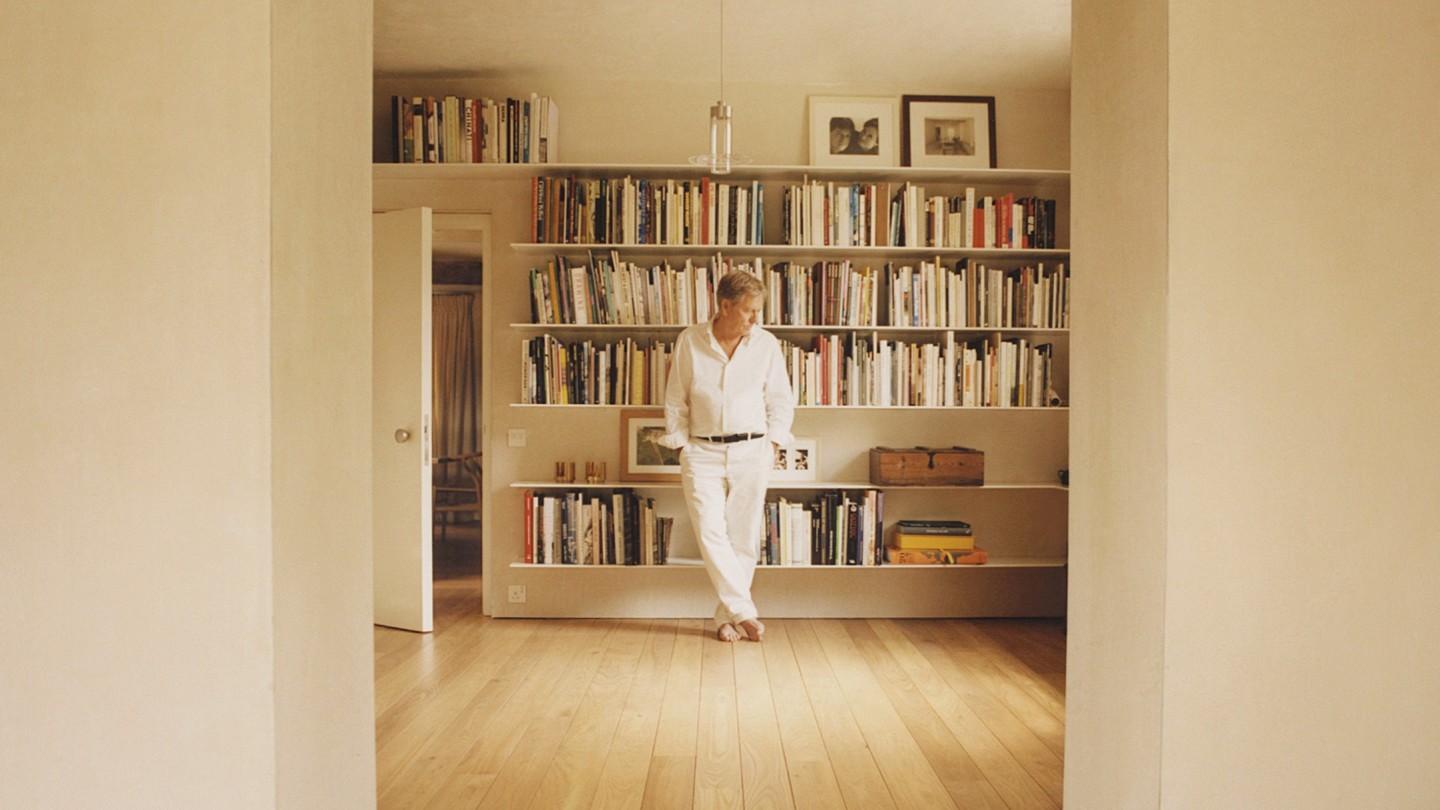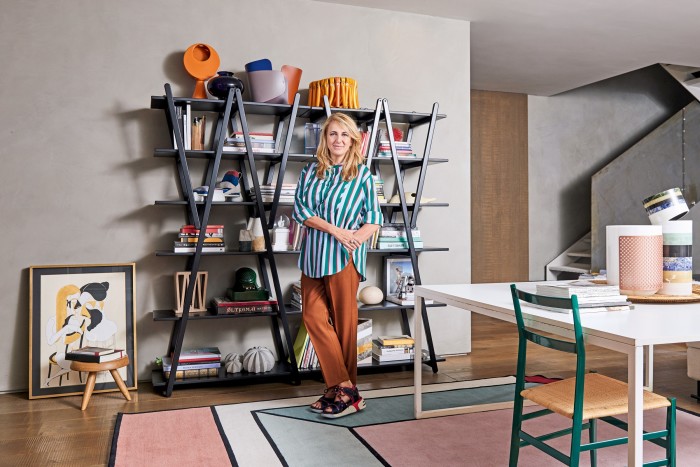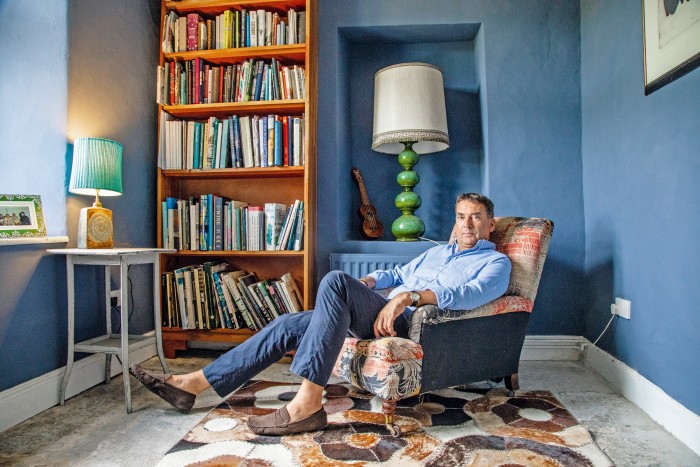Shelf life: What do the bookcases of designers reveal?

Roula Khalaf, Editor of the FT, selects her favourite stories in this weekly newsletter.
Architect John Pawson
“I’m not keen on seeing other people’s books, nor on them seeing mine. Everyone says, ‘Aren’t they lovely? So decorative and homely and cosy.’ For me, they’re a working tool. But that’s what Catherine [John’s wife, the interior designer Catherine Pawson] wanted, so when we got this house in the country [near Moreton-in‑Marsh, Gloucestershire], I designed a bookcase.
We’ve been in the house for a year now and it’s definitely a work in progress. I like to think of it as my laboratory where I experiment. There are many things I understand better by doing them first in my own home. The plan for the library was just to see the books, not the shelves – so they’re very thin 10mm aluminium, cantilevering from the wall and running all the way around the room. The walls are unpainted lime plaster and the shelves are finished in an off-white, so visually they almost disappear. I got the idea when visiting [British architect] Amanda Levete’s house. She has her own set of slim metal bookshelves. Of course, I did things differently – mine float.
The room is an office, study and library with a table and a computer. It gets plenty of sunshine because it faces south, and it opens on to a very light reading room with an easy chair. The idea is you take your book and retire to the reading room. The thing about architecture is that you’re consumed by buildings for much of the time – whether you’re thinking about them or checking on stuff written about them. I’m obsessive, but I do believe there should be a lot more time for poetry, philosophy or fiction. I intend to read more. I was given the entire works of Proust for my birthday. I wonder if it’s going to sit there making me feel inadequate.
Among the books are a few mementoes. There’s the odd model of mine, a Japanese wooden toy temple that you put together yourself – it’s exquisite – and a pre-Columbian art statue. The statue came to me via Hester [the art dealer Hester van Royen, mother of John’s son, Caius, and stepdaughter, Phoebe]. I think it might have been a gift from the writer Bruce Chatwin. He was Caius’s godfather and I did up his flat in Belgravia. I don’t like much art in the house. I love it, study it and like to see it in museums, but I’m quite happy without it on the walls at home. It’s the same with knick-knacks. I look at them, pick them up and like how they remind me of things. But there’s so many things to be reminded of. How much can you cope with?
Growing up in Yorkshire, we had lots of time to read as children. The house was filled with books – in the corridors, bedrooms and piled in the hallway. I had four sisters and every time one of them married and went away, Dad knocked through a wall, which meant my room got larger. But as it grew, I resisted filling it with anything – including books. It remained spacious.” johnpawson.com

Designer Patricia Urquiola
“My favourite bookcase is in my sitting room and can be seen from the entrance as you walk into the house. It sits in front of the table where I have lunch. I have other ones, but those are just grey metal shelves – part of the architecture. I wanted this one because it’s by Vico Magistretti. He and Achille Castiglioni were mentors during my career, and I felt it was important to own one of his pieces. It’s the Nuvola Rossa designed for Cassina. I have two – the other one is positioned on the opposite wall of the room.
I remember Vico’s sketches for this bookcase were so interesting, I always keep them in mind when I look at the shelves. I worked on his team at De Padova for a short time as a young designer and this bookcase is a constant reminder of him throwing me things to do and saying you have to do this or that. It was designed in 1977 and has been produced nonstop ever since. It’s evergreen, which is amazing – that doesn’t happen every day. What I admire is the simplicity, the sensuality that Vico always put into his work. It’s a fantastic example of quality design – very easy to reproduce but with a language and an essential message.
I live above my studio and I’m always changing and moving things around. I buy things, I try things – it’s part of the way I live my life. On the bookcase [second shelf up] is a green Phonola radio. It was the first thing that Achille Castiglioni told me he’d worked on. He was so young at the time, his name doesn’t even appear on it, but he helped his elder brothers Pier Giacomo and Livio Castiglioni, along with [architect and furniture designer] Luigi Caccia Dominioni – a very important personality in our culture of design and architecture in Milan – who are credited with the design.
At my graduation, my friends asked me what I wanted as a gift. I told them, ‘The first thing Achille worked on – it will bring me luck.’ So they clubbed together and bought it for me in an antiques shop. I love to have things around me from people who have shared my life. The dark blue vase [on the top shelf] is from [architects] Franco Albini and Franca Helg. They gave it to me 20 years ago. When I move house, it comes with me. Then there’s the orange ceramic, a vintage piece from Bitossi, something that one of my friends gave my husband and I when we married. The orange bowl is called Ceste, and is made from irrigation hose by a guy called Roberto Mora. I remember seeing it a few years ago when visiting my friend Rossana Orlandi [the Milanese gallerist]. I immediately thought, ‘Ooh, I need to take that home!’
I have a lot of my prototypes on the bookcase. There’s a Mutina tile called Celosia and the red skull was made for an opera in Spain [The Coronation of Poppea by Monteverdi, which was performed in Urquiola’s hometown of Oviedo for the first time in 2010 – she designed the set]. On the third shelf down, there’s a prototype of a low seat, the Wasting Time daybed, that I took home with me – it’s a giant sneaker-shaped bed, designed as part of Rossana Orlandi’s Guiltless Plastic project for Milan Design Week in 2018. It’s composed entirely of recycled PET plastic. Reusing waste is a topic that has interested me for many years. Such designs are part of a poetical new sustainability – how to approach any kind of leftovers and make them into something of value.
On the fifth shelf down is my robot dog. It belonged to my daughter who got it for Christmas a few years ago. She’s now 14 and doesn’t want to use it any more, so I told her, ‘Give it to me. I like it.’ Most of the shelves in the house are filled with books but this one is different – it also displays objects of personal importance. A bookcase always says something about you. It reveals aspects of your life. This is a very special one as it’s the Vico bookcase.” patriciaurquiola.com

Designer and leatherwork specialist Bill Amberg
“When we moved into this house in Somerset 14 years ago, there was a very old cherry tree in the garden. It had stopped producing fruit but still had a lovely strong, straight trunk. After a couple of years, I thought I’d replace this lone, ailing tree with a new orchard. I didn’t want it to go to waste so I chopped it down and took the trunk to a local timberyard where they cut it into two-inch planks. I put them in the rafters of my barn and left them there for three years until the wood was completely stable and dry – and I had fully given thought to what I’d use it for.
I have a very nice, cocoon-like study in the house and I wanted a bookcase that would complement the rich, Edward Bulmer navy-blue wall. I spoke to a local joiner called Paul Vincent, who makes very beautiful furniture, and commissioned him to craft the piece to my design.
My thinking was to have sturdy but elegant shelves, partly inspired by David Mlinaric, as I’d noticed he uses thick boards but with a pretty thin, tapered front edge. I was also keen that the wood was not covered in a horrid tacky varnish, so it is simply sanded back. I love the cherry-wood colour and the way it looks with the blue walls. The shelves have beautiful vegetable-tanned leather detailing that I sourced from one of my favourite tanneries in Europe. It’s a particular cut of a cowhide – the shoulder section – which carries the most grain so it sits well with the natural character of the timber.
Our house was built in 1642 and the study has a stone mullion window with leaded lights and the original Blue Lias stone floor. The room looks out over Cogley Wood and used to be the coal store, so it’s a naturally cool space but makes for a very nice reading room – the perfect place to sit and contemplate. I keep a collection of books, maps and art publications on the shelves. I’m a keen reader, buy lots of reference books and collect catalogues from shows and galleries I like.
Most of them are books on photography, architecture or furniture, but there are also recipe books and specialist titles about old cars and bikes. In other words, my collection represents a variety of passions. My favourite cookbook at the moment is from Gjelina, the restaurant in Venice Beach, LA, serving New American cuisine. I’m also enjoying Luciano Giubbilei’s book about gardens. I heard him speak recently at At The Chapel, a wonderful restaurant and hub of the local community in nearby Bruton. As a result, we’re in talks about doing a furniture collaboration together.
There’s a wide and eclectic mix of books and objects on the shelves at the moment. As new ones arrive, the objects are shunted elsewhere – the books are definitely taking over! When the bookcase was a cherry tree standing in the garden, my three daughters and I used to pin targets to it and shoot our air rifles at it for practice. So when Paul was making the piece, he found various pellets in the wood. He was terribly nervous and said that perhaps he should take them out and fill in the holes with something more suitable. I said I’d be very happy to have my pellets preserved in the wood. It’s a family legacy.” billamberg.com
Comments